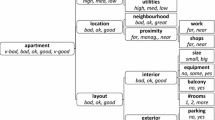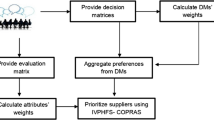Abstract
This paper presents a method using intervals for representing and synthesizing imprecise information for multi-attribute evaluation and decision-making support. An implementation is given for selecting an alternative for a project in a real case in the context of construction in civil engineering. As a previous step to aggregate the available information, a methodology is proposed for summarizing and normalizing values in an intervals context, representing the alternatives by means of rectangles in \(\mathbb R^n\) (products of n finite closed intervals in \(\mathbb R\)). A distance is introduced in the set of rectangles, defining a total order once a reference rectangle is considered. A method is given for the choice of the best alternative based on the comparison of distances to a reference rectangle. The constraints which guarantee consistency are determined and the consistency of the method is established.
This work has been partially supported by the MCyT (Spanish Ministry of Science and Technology) projects MERITO (TIC2002-04371-C02) and MIVES (MAT2002-04310-C03-01).
Preview
Unable to display preview. Download preview PDF.
Similar content being viewed by others
References
Al-Subhi, K.M.: Application of the AHP in Project management. International Journal of Project Management 19, 19–28 (2001)
González Pachón, J., Romero López, C.: Aggregation of partial ordinal rankings. An interval goal programming approach 28, 827–834 (2001)
Kallio, M., Lewandowski, A., Orchard-Hays, W.: An Implementation of the Reference Point Approach for Multi-Objective Optimization. WP-80-35, IIASA, Laxenburg (1980)
Keeney, R.L., Raiffa, H.: Decisions with multiple objectives preferences and value trade-offs. Cambridge University Press, Cambridge (1993)
Ormazabal, G.: IDS: A new integrated decision system for construction project management. PhD Thesis, Department of Construction Engineering, Technical Univ.of Catalonia (UPC), Barcelona, Spain (2002)
Romero López, C.: Extended lexicographic goal programming: A unifying approach. Omega, The International Journal of Management Science 29, 63–71 (2001)
Romero López, C., Tamiz, M., Jones, D.: Comments on goal programming, compromise programming and reference point method formulations: linkages and utility interpretations-A reply. Journal of the Operational Research Society 52, 962–965 (2001)
Saaty, T.L.: The Analytical Hierarchy Process. Ed. Willey, New York (1990)
Wierzbicki, A.P.: The use of reference objectives in multiobjective optimization. In: Fandel, G., Gal, T. (eds.) Multiple Criteria Decision Making; Theory and Applications. Lecture Notes in Economic and Mathematical Systems, vol. 177, pp. 468–486. Springer-Verlag, Berlin-Heidelberg (1980)
Author information
Authors and Affiliations
Editor information
Editors and Affiliations
Rights and permissions
Copyright information
© 2006 Springer-Verlag Berlin Heidelberg
About this paper
Cite this paper
Prats, F., Sánchez, M., Agell, N., Ormazabal, G. (2006). An Evaluation Method with Imprecise Information for Multi-attribute Decision Support. In: Marín, R., Onaindía, E., Bugarín, A., Santos, J. (eds) Current Topics in Artificial Intelligence. CAEPIA 2005. Lecture Notes in Computer Science(), vol 4177. Springer, Berlin, Heidelberg. https://doi.org/10.1007/11881216_15
Download citation
DOI: https://doi.org/10.1007/11881216_15
Publisher Name: Springer, Berlin, Heidelberg
Print ISBN: 978-3-540-45914-9
Online ISBN: 978-3-540-45915-6
eBook Packages: Computer ScienceComputer Science (R0)




